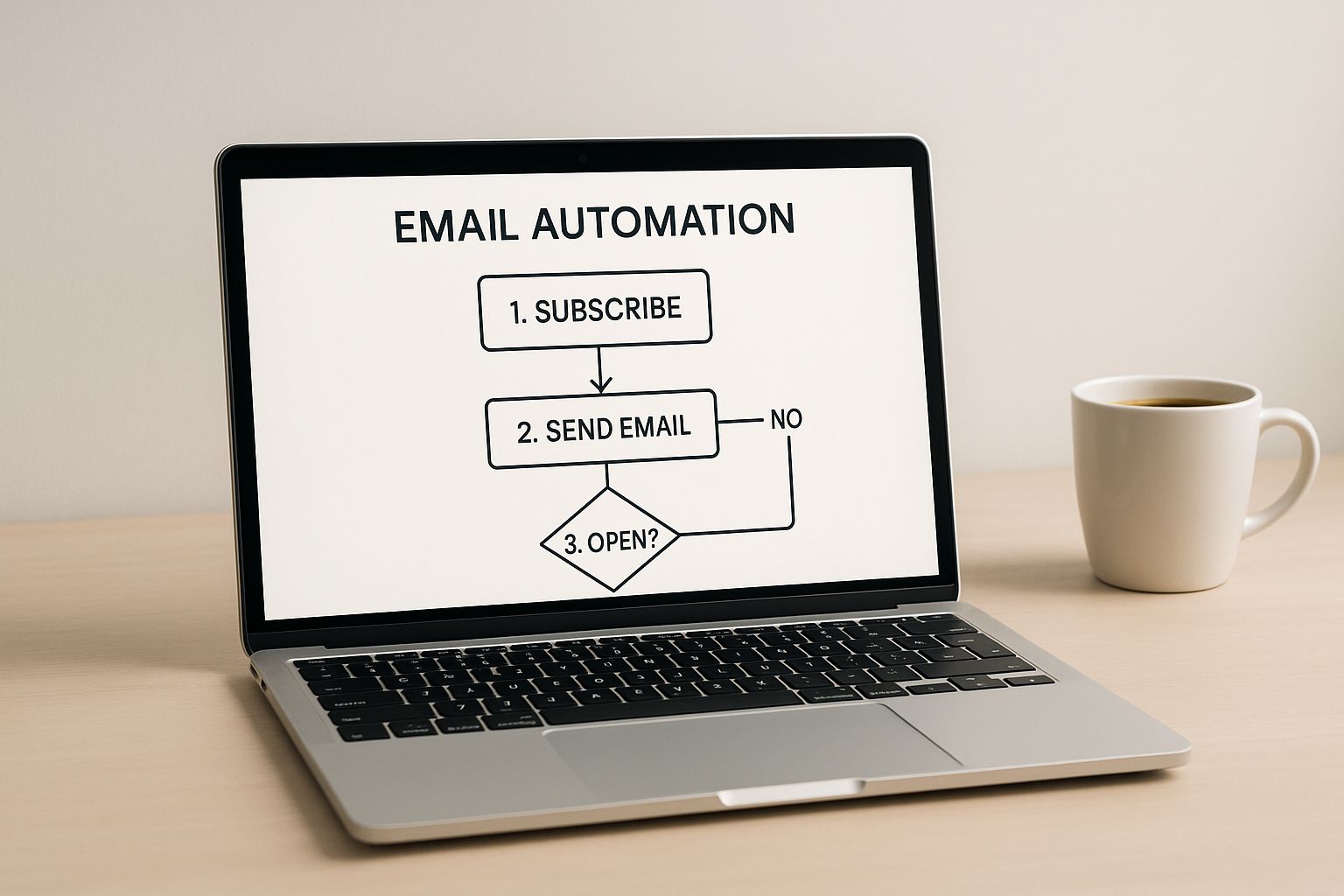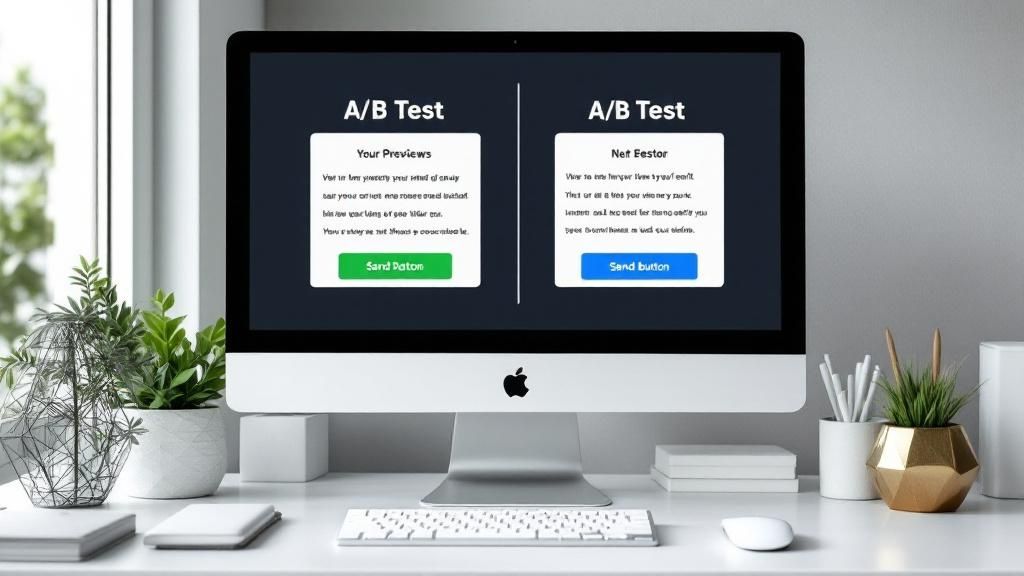A successful marketing automation setup isn't about the software—it's about the strategic thinking that happens before you even look at platforms. Time and again, companies that win with automation are the ones who first take a hard look at their current marketing, set crystal-clear goals, and map out their customer journeys.
This groundwork is what makes the technology work for you, not the other way around.
Building Your Foundation for Automation Success
It's tempting to jump right into vendor demos and get wowed by flashy features. That's a classic mistake. The most effective implementations begin with introspection. Before you can automate a single task, you need a painfully honest understanding of what you’re currently doing, what’s actually working, and where your team is feeling the most friction. This is where you draw the blueprint for your entire project.
Getting this right is more important than ever. The marketing automation market was valued at $4.79 billion in 2021 and is projected to reach $6.62 billion in 2024. This isn't just a niche tool anymore; it's a standard part of the modern business toolkit, with projections showing the market could nearly double by 2030. You can dig into more of the data behind these market trends to see just how quickly things are moving.
Audit Your Current Marketing Processes
First, take a candid look under the hood of your marketing and sales operations. Where are the repetitive, manual tasks eating up your team's day? Map out what happens from the second a new lead comes in.
- The Lead Handoff: How does a lead get from marketing to a sales rep? Is it a clunky spreadsheet export or a messy "FWD: New Lead" email chain?
- Your Follow-Up Game: What happens after someone downloads your latest guide? Is the follow-up instant and consistent, or does it sit in a queue waiting for someone to find a spare moment?
- Nurturing Contacts: How are you staying in touch with people who are interested but not ready to buy? Are you just blasting a monthly newsletter and hoping for the best?
Pinpointing these friction points shows you exactly where automation can deliver the biggest, fastest wins. For example, if good leads are consistently going cold before sales can call them, an automated lead routing and notification workflow should be at the top of your list.
Expert Insight: Don't just hunt for problems. Look at what's working well, even if it's manual. That killer email template your top rep uses? The follow-up script that always gets a response? These are perfect starting points for building your first automated workflows.
Set Clear and Tangible Goals
You've diagnosed the pain points. Now, what do you actually want to achieve? A vague goal like "get better at marketing" is a recipe for a failed project and wasted money. Your objectives must be specific, measurable, and tied directly to real business outcomes.
Each goal demands a different automation strategy. Are you trying to:
- Increase lead volume? You’ll focus on top-of-funnel content delivery and capturing new contacts.
- Improve lead quality? You’ll build out lead scoring models to separate the tire-kickers from the ready-to-buy prospects.
- Boost customer retention? Your priority will be automated onboarding campaigns or re-engagement sequences for dormant customers.
- Shorten the sales cycle? You’ll need workflows that deliver the right information at the right time to remove buyer friction.
To help you get specific, think about your primary objectives. The table below outlines a few common goals to get you started.
Core Goals for Your Marketing Automation Strategy
Anchoring your plan to a primary business objective is crucial. This table breaks down common goals, how you might measure them, and what kind of business they're best suited for.
This isn't an exhaustive list, but it's a solid framework. Pick one primary goal to start. You can always expand later, but a focused launch is a successful launch.
Map the Entire Customer Journey
Finally, you have to walk in your customer's shoes. Map out every step they take, from their first touchpoint to becoming a loyal advocate. This isn’t just a marketing flowchart; it's about seeing the world from their perspective.
What questions are they asking at each stage? What information do they need to feel confident enough to take the next step?
A good customer journey map visualizes these touchpoints. It shows you the exact moments where an automated, helpful, and personalized message can make all the difference. This map transforms your plan from a collection of disconnected tasks into a cohesive, guided experience. It becomes your playbook for every workflow you build.
How to Choose the Right Automation Platform
Picking your marketing automation tool is a significant decision. This isn't just about software; it’s about choosing a partner for growth. The right platform feels like an extension of your team, while the wrong one quickly becomes an expensive, frustrating roadblock. You have to look past the flashy sales demos and determine what your business truly needs to succeed.
The stakes are high. The market is flooded with options, but many don't hit the mark. While 84% of businesses are ready to invest in automation software, a staggering 66% feel their current platforms don't fully meet their needs. This gap between promise and reality highlights why a structured, thoughtful evaluation is essential. You can see more on the challenges in marketing software adoption at emailvendorselection.com.
All-in-One Suites vs. Best-of-Breed Tools
First, you need to decide on your core philosophy. Are you looking for a single, unified system or a curated collection of specialized tools?
All-in-One Platforms: Think of these as the Swiss Army knives of marketing. They aim to cover everything—email, social media, landing pages, analytics, and CRM—all under one roof. The appeal is clear: one login, one bill, and data that (in theory) works together seamlessly. This is often the best path for teams who value simplicity and want to avoid the technical complexities of integrating different systems.
Best-of-Breed Stacks: This is the à la carte approach. You pick the absolute best tool for each job—perhaps Mailchimp for its email prowess, Hootsuite for social media management, and Unbounce for high-converting landing pages. You get top-tier functionality across the board, but the trade-off is managing the integrations to ensure all systems communicate properly.
A small business just starting its marketing automation implementation would likely find an all-in-one solution more manageable. Conversely, a mature tech company needing highly sophisticated analytics might build a best-of-breed stack to get the precise power it requires.
A Note from Experience: Too many companies are drawn in by the "all-in-one" dream, only to discover their chosen platform is a jack-of-all-trades and master of none. If one specific function, like hyper-detailed email personalization, is the lifeblood of your strategy, you either need a suite that truly excels there or you should be prepared to build a stack.
Evaluate Vendors on What Truly Matters
Once you’ve settled on a direction, it’s time to put the vendors under a microscope. Forget the marketing fluff. Here’s what you should focus on.
Usability and Your Team’s Skills
How easy is it to actually use the platform? A tool can have countless features, but they’re worthless if your team is too intimidated to log in. Always ask for a sandbox account or a live, hands-on demo. Then, have the people who will be in the driver's seat try to build a simple email workflow or a landing page. Their feedback is invaluable.
Integration Capabilities
This is a deal-breaker. Your marketing automation platform must integrate seamlessly with your CRM and other critical tools. A clunky integration creates data silos, which is the exact problem automation is supposed to solve. Don’t settle for a vague "Oh yeah, we integrate." Ask to see it in action. How does it sync with your specific tech stack? Is the data flow truly bidirectional?
The Quality of Customer Support
Sooner or later, something will go wrong—a workflow might break before a major launch, or a report won't pull the right data. When that happens, how quickly can you get a real, knowledgeable human to help you? Scour review sites and, if possible, talk to current customers to get the real story on their support experience.
Scalability and Your Future Growth
The platform you choose today must support your business a year or even five years from now. Look closely at the pricing tiers. Do they penalize you for growing your contact list? Are essential advanced features locked away in an "enterprise" plan with a steep price tag? You want a partner that can grow with you, not one you’ll outgrow.
The Non-Negotiable Features Checklist
Every business has unique needs, but some features are foundational to any successful marketing automation implementation. Use this table as a starting point to build out your own list of must-haves versus nice-to-haves.
By focusing on your strategic needs—usability, integration, and scalability—instead of just the flashiest new features, you can confidently select a platform that will become a true engine for your business's growth. This careful selection process is the cornerstone of a successful marketing automation implementation.
Getting Your CRM and Data Integration Right

Think of your marketing automation platform as a powerful engine. What fuels that engine? Clean, synchronized data. A successful marketing automation implementation lives or dies by how well it communicates with your Customer Relationship Management (CRM) system. Get this wrong, and you end up with data silos and frustrated teams—the very problems you’re trying to solve.
The goal is to create a single source of truth. This isn’t about flipping a switch to connect two apps; it’s about building a complete, 360-degree view of every customer touchpoint. When you nail this, your marketing and sales teams aren't just on the same page; they’re working from the same playbook. Without it, marketing wastes time nurturing leads sales can't see, and sales provides feedback that never makes it back to marketing to improve campaigns.
First, Clean Up Your Data
Before you think about connecting your systems, assess the state of your existing data. Trying to sync a messy CRM with a shiny new automation platform is like pouring sludge into a Ferrari engine. It’s a guaranteed recipe for failure.
Start with a serious data audit and cleanup. This means rolling up your sleeves and:
- Merging duplicates: Eliminate multiple records for the same person.
- Standardizing fields: Ensure everyone uses "CA" and not a mix of "California," "Calif.," and "Cali." Consistency is key.
- Purging old contacts: Remove bounced email addresses and contacts who haven't engaged in years. They're just dead weight.
This initial deep clean is non-negotiable, but remember, data hygiene is a habit, not a one-time project. For a more detailed guide on setting up these systems for long-term success, check out our post on strategic CRM implementation. It’s packed with best practices for building a clean database from the ground up.
Map Your Fields for a Two-Way Conversation
Once your data is sparkling clean, it’s time to map the fields between your CRM and your automation tool. This is where you decide what information gets shared and which system has the final say when data conflicts. A true two-way sync is absolutely essential here.
Imagine a salesperson updates a lead’s status to "Contacted" in the CRM. That change must instantly flow back to your automation platform. This can trigger a workflow that pulls the lead out of a nurturing sequence, so you don't send them an awkward "Hey, we haven't met yet" email right after a call.
It works the other way, too. When a lead clicks a pricing page link (tracked by your automation tool), that valuable behavioral data should appear on their CRM record. This gives your sales rep critical context for their next conversation.
Expert Tip: A major mistake is implementing a one-way data push from the automation tool to the CRM. It leaves the sales team flying blind, unaware of real-time marketing engagement. A bidirectional sync isn't a "nice-to-have"—it's a must.
Define Your Lead Lifecycle and Scoring
With data flowing freely between systems, you need a common language for your sales and marketing teams. This begins with a crystal-clear definition of each stage of your lead lifecycle.
- Subscriber: Someone who opted in but has not yet shown significant intent.
- Marketing Qualified Lead (MQL): A contact who has hit a key engagement threshold (like downloading a guide) and fits your ideal customer profile.
- Sales Accepted Lead (SAL): An MQL that the sales team has reviewed and agreed is worth pursuing.
- Sales Qualified Lead (SQL): A lead that sales has vetted and confirmed is a legitimate, active opportunity.
Getting both teams to agree on these definitions is half the battle. It ends the age-old "marketing is sending us junk leads" debate.
To bring this to life, you'll build a lead scoring model. This system automatically assigns points to contacts based on their demographics and behaviors.
Once a contact hits a certain score (say, 100 points), the system automatically flags them as an MQL and sends them to the sales team's queue. This data-driven handoff ensures your sales team focuses its energy only on the hottest leads, which is a game-changer for efficiency and conversion rates. This is the real power of a well-executed marketing automation implementation.
Building Your First High-Impact Workflows
Your platform is live and data is flowing. Now for the engaging part: turning all that planning into tangible, automated experiences that drive results.
The secret is to resist the urge to automate everything at once. Too many teams get overwhelmed by trying to build a dozen complex workflows from day one. Instead, focus on a few foundational campaigns that solve an immediate problem. Start simple, score some early wins, and build momentum. This approach proves the platform's value and gets your team excited about what's possible.
The image below lays out a basic but powerful workflow. Think of it as a visual map showing how a single trigger can kick off a journey that guides a new contact toward a specific goal.

This blueprint is a great reminder that automation isn't just about sending emails; it's about creating a responsive journey that adapts to how people interact with your brand.
To get started, let's look at three essential workflows that deliver immediate value. I've broken them down in this comparison table to give you a quick overview of what they do and why they matter.
Essential Automation Workflow Comparison
These three workflows are the bedrock of a solid automation strategy. They're straightforward to build and deliver measurable results almost immediately, making them the perfect place to start.
Launch a Powerful Welcome Series
If you only build one workflow to start, make it a welcome series. This is your chance to make a fantastic first impression, set expectations, and start building a relationship. Engagement rates on these emails are almost always higher than your regular marketing sends, so it's a guaranteed win.
Here’s a simple, effective blueprint:
- The Trigger: A user fills out a form—perhaps to join your newsletter or create an account.
- Email #1 (The Welcome Mat): Send this within minutes. It should confirm their subscription, say thank you, and deliver whatever you promised (like a discount code or an ebook).
- The Follow-Up: Wait 2-3 days, then send a second email. This is a great spot to share your brand's story, showcase your most popular products, or point them to a killer blog post.
- The Gentle Nudge: After another 3-4 days, send a final email. This could be another piece of valuable content or an invitation to connect on social media.
This sequence does more than just say "hi." It conditions your new contacts to look for and open your emails, establishing your brand as a helpful, consistent voice in their inbox.
Re-Engage Your Dormant Contacts
Every marketing database has them: contacts who signed up with interest but have since gone silent. A re-engagement campaign, or "win-back" workflow, is your secret weapon for waking up these cold leads. It's far cheaper to reactivate an existing contact than to find a new one.
Here’s how to structure it:
- The Trigger: A contact hasn’t opened or clicked an email in the last 90 days.
- Email #1 (The Nudge): Send an email with an attention-grabbing subject line, like "Is this goodbye?" or "We've missed you." Inside, offer a compelling reason to return, like a special discount or a link to your best new content.
- The Split: If they open or click, great! Tag them as "Re-engaged" and pull them from this workflow. If not, wait 7-10 days.
- Email #2 (The Last Call): This is the final attempt. Be upfront and explain that you'll remove them from your active list to respect their inbox unless they click to stay subscribed.
- The Cleanup: If there's still no activity, automatically tag them for removal. This keeps your list healthy and your deliverability scores high.
A well-planned win-back campaign can bring back up to 15-20% of your inactive subscribers. It’s a double win: you get a potential revenue boost while also protecting your sending reputation by cleaning your list.
If you're ready to explore more advanced techniques, our guide on how to master marketing workflow automation dives into more complex strategies and real-world examples.
Personalize with Dynamic Content
Finally, remember that good automation should never feel robotic. The data you've synced from your CRM and other tools is pure gold for making your messages feel personal and relevant. This is where dynamic content comes in.
This feature lets you display different text, images, or calls-to-action to different segments of your audience, all within a single email.
For instance, an e-commerce brand could design one promotional email that automatically shows:
- Womenswear to subscribers identified as female.
- Menswear to subscribers identified as male.
- A special "thank you" offer to VIP customers who have spent over $500.
This kind of personalization transforms a generic email blast into a tailored message that speaks directly to each recipient. It’s a surefire way to increase relevance and click-through rates. By starting with these three foundational workflows, you'll create immediate value and build a solid base for more sophisticated automation down the line.
Getting Your Team to Actually Use the New System
Let's be honest: a powerful marketing automation platform is just an expensive piece of software if your team doesn't use it. You can spend months on the perfect marketing automation implementation, but its true value is only unlocked when people embrace it and weave it into their daily work. This part is about people, not technology.
If you don't get buy-in, you'll end up with "shelfware"—a costly tool gathering digital dust. The focus must shift from the technical setup to the human side of things. Your goal is to ensure this new system empowers your team, not overwhelms them.
Build a Training Plan That Makes Sense
A one-size-fits-all training session is a waste of everyone's time. Your content marketer and your top sales rep use the platform for completely different reasons. A generic overview will leave them confused and frustrated.
You need to break down your training by role. This way, everyone learns exactly what they need to know for their job, which builds confidence from the start.
- Marketers: These are your power users who need a deep dive. Focus their training on building campaigns, thinking through workflow logic, segmenting audiences, and creating landing pages. They are the ones who will bring your strategy to life inside the tool.
- Sales Reps: They don't need to know how to build a nurture sequence. They need quick, actionable training on what matters to them: interpreting lead scores, getting real-time alerts for hot prospects, and using the new CRM data to have smarter conversations. Keep it focused on closing deals.
- Leadership: Your executives don’t need to be in the weeds. Show them how to access high-level performance dashboards. They need to see the ROI and track big-picture business metrics. They want to understand the impact of the workflows, not how to build them.
Answer the "What's in It for Me?" Question
The quickest way to get people on board is to show them how this new system makes their specific job better. Forget abstract benefits like "improved efficiency." People care about personal wins.
Show your sales team how an instant alert when a prospect downloads a pricing sheet means they can call that person minutes—not days—later. Explain to your marketers that by automating tedious emails, they’ll finally have time for the creative, strategic campaigns they enjoy.
When you frame the change around individual benefits, you turn reluctant users into genuine fans. It stops feeling like a mandate and starts feeling like a tool that makes their work easier and more rewarding.
Put Clear Rules in Place with an SLA
To get marketing and sales working together instead of pointing fingers, you need a Service-Level Agreement (SLA). Think of it as a formal pact that defines exactly what each team is responsible for. It creates accountability.
A solid SLA for your marketing automation implementation needs to spell out a few key things:
- The Handoff Point: What makes a lead "sales-ready"? Define the specific lead score or actions that officially turn a lead into a Marketing Qualified Lead (MQL).
- The Follow-Up Window: How long does sales have to act on a new MQL? Be specific (e.g., "within 4 business hours for a 'demo request' lead, 24 hours for others").
- The Feedback Loop: How does sales inform marketing if leads are good or bad? Create a simple process for them to mark lead status in the CRM. This is crucial for helping marketing improve its campaigns.
This shared agreement gets everyone on the same page. Marketing is on the hook for delivering quality, and sales is on the hook for following up. It’s the bedrock of a smooth, productive funnel.
Measuring ROI and Optimizing for Growth

Getting your first automation workflow live isn't the finish line; it’s the starting pistol. The real, lasting value from any marketing automation implementation comes from what you do next: building a constant loop of measuring, analyzing, and tweaking. This is how you prove your investment was worthwhile and turn your platform into a true engine for growth.
Many businesses fall into the "set it and forget it" trap. They build a few workflows, pat themselves on the back, and move on, never checking if their efforts are moving the needle. To avoid this, you must embrace a data-first mindset, always looking for ways to refine and improve your strategy.
Move Beyond Vanity Metrics
The first step in showing real value is tracking the right Key Performance Indicators (KPIs). Open rates and click-throughs are fine for a quick pulse check on email engagement, but they don't tell the whole story. To truly demonstrate ROI, you must connect your marketing activities directly to revenue.
This means building dashboards that highlight the metrics your leadership team cares about. Instead of just reporting how many emails you sent, focus on the numbers that show real business impact.
- Marketing-Influenced Pipeline: What’s the total value of all sales opportunities that were touched by a marketing campaign? This shows how your automation is directly feeding the sales funnel.
- Customer Lifetime Value (CLV): How does your automation affect the total revenue a customer brings in over their relationship with you? A solid onboarding or retention workflow can send this number soaring.
- Cost Per Acquisition (CPA): How much are you spending to bring in a new customer through your automated channels? As you optimize workflows, this number should decrease, proving greater efficiency.
When you start focusing on these revenue-centric KPIs, you change the conversation from "marketing is a cost" to "marketing is a revenue driver." For more on which numbers matter most, check out our in-depth guide on mastering digital marketing performance metrics.
By consistently tying automation activities to financial outcomes, you build a powerful business case for your work. You're no longer just sending emails; you're actively contributing to the bottom line, which is a story every executive wants to hear.
The Power of Systematic A/B Testing
Once your core metrics are in place, it’s time to improve them. The most effective way to do this is with disciplined A/B testing. This isn't about throwing things at the wall to see what sticks; it's a methodical approach to discovering what resonates with your audience.
Don't try to test everything at once. Begin with a clear hypothesis. For instance: "I believe using a question in the subject line will boost our open rates by sparking curiosity." Then, create two versions of your email—one with a statement and one with a question—and send them to a small, random segment of your list.
You can apply this same thinking to almost every element of your automated campaigns:
The key is to only test one variable at a time. If you change both the subject line and the call-to-action, you'll have no idea which change actually caused the results.
Create a Culture of Constant Refinement
Ultimately, you want to bake optimization into your team's DNA. This means scheduling regular meetings to review performance dashboards, discuss learnings from recent A/B tests, and brainstorm new experiments to run.
This continuous loop of measure, test, learn, and repeat is what separates good marketing automation from great marketing automation. It ensures your marketing automation implementation isn't a one-time project but a living, breathing part of your growth strategy that adapts and improves over time. This commitment to ongoing optimization is what will keep you ahead of the competition and deliver powerful results for years to come.
Unpacking Your Marketing Automation Questions
Even the most well-structured implementation plan can have loose threads. It’s normal for questions to arise, as every business brings its own unique challenges to the table. Let's tackle some of the most common questions we hear from teams just like yours.
How Long Does a Typical Implementation Take?
This is the big one, and the honest answer is: it depends. I've seen projects go from kickoff to live in just a few weeks, while others take the better part of a year.
A more straightforward setup—think basic tool configuration and a simple welcome series—can realistically be up and running in 4-6 weeks. This approach is great for getting quick wins and building momentum.
However, if you're looking at a full-scale overhaul with deep CRM integration, a massive data cleanup project, and a dozen complex workflows, you should budget for 3-6 months. The key is to avoid a "big bang" launch and instead break the project into manageable phases.
What Is the Biggest Mistake to Avoid?
The most common mistake is getting completely dazzled by the technology while forgetting about the strategy. It's easy to get excited about the bells and whistles of a powerful new platform, but jumping in without a clear plan is a recipe for disaster.
If you haven't mapped out your customer journeys, defined your goals, or prepared your data, you're setting yourself up for failure.
I can't stress this enough: your strategy has to come first, always. A brilliant strategy with a basic tool will run circles around a chaotic implementation with the most expensive platform on the market. Strategy must always come before software.
Do I Need a Dedicated Person to Manage This?
For any business that's serious about getting a real return on this investment, the answer is a firm yes. While the platforms themselves are becoming more intuitive, the strategic work is what truly drives results.
Someone needs to own the high-level strategy, build and tweak workflows, maintain data hygiene, and analyze performance reports. This isn't a side-of-the-desk task that can be knocked out in a spare hour.
Depending on your company's size, this could be a full-time marketing operations manager or a significant part of a skilled marketer's role. The key is that it requires dedicated focus.
Ready to move beyond questions and start seeing results? The team at Twelverays specializes in strategic marketing automation and CRM implementation that drives real business growth. We help you build the foundation, choose the right tools, and create workflows that convert. Start your journey with us today.





